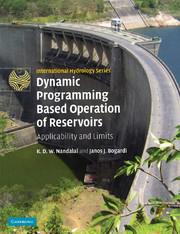Book contents
- Frontmatter
- Contents
- List of figures
- List of tables
- Preface
- 1 Water resources management
- 2 Incremental dynamic programming in optimal reservoir operation
- 3 Stochastic dynamic programming in optimal reservoir operation
- 4 Optimal reservoir operation for water quality
- 5 Large-scale reservoir system operation
- 6 Optimal reservoir operation for flood control
- References
- Index
1 - Water resources management
Published online by Cambridge University Press: 14 August 2009
- Frontmatter
- Contents
- List of figures
- List of tables
- Preface
- 1 Water resources management
- 2 Incremental dynamic programming in optimal reservoir operation
- 3 Stochastic dynamic programming in optimal reservoir operation
- 4 Optimal reservoir operation for water quality
- 5 Large-scale reservoir system operation
- 6 Optimal reservoir operation for flood control
- References
- Index
Summary
GENERAL
The water resource has a major influence on human activities. It is a major input in almost all sectors of human endeavor. Water serves essential biological functions and no human can survive in its complete absence. Water's contributions to human welfare include its role as a basic element of social and economic infrastructure. Also important are water's natural attributes that contribute to human aesthetic enjoyment and general psychological welfare. But water also has negative impacts on human well-being. Floods, inundations, and water-borne diseases are also associated with water.
Water has played a major role in socio-economic development due to the magnitude and widespread occurrence of its positive and negative impacts. The quality of human life is directly dependent on how well these resources are managed. Water management activities are intended to enhance the positive contributions of water or control its negative impacts.
Ancient civilizations grew up in the river valleys of the Tigris and Euphrates, Nile, Indus, Yellow River, etc., where there was plenty of water. Water management activities, particularly irrigation, played a central role in the development of these civilizations. In those days the planning and management of the water resources were primarily for single uses. The continuing growth of the human population, especially since the nineteenth century, together with rapid industrial development and rising expectations of a better life necessitated more complex and consistent water resources management. These competing demands and uncontrolled use, along with the pollution of water, have made it a scarce resource.
- Type
- Chapter
- Information
- Dynamic Programming Based Operation of ReservoirsApplicability and Limits, pp. 1 - 15Publisher: Cambridge University PressPrint publication year: 2007



